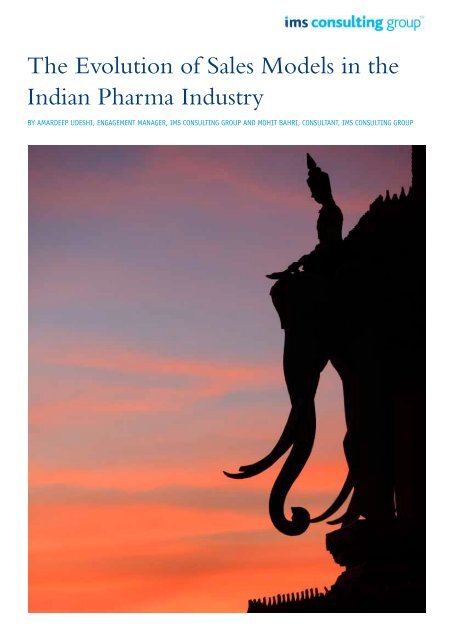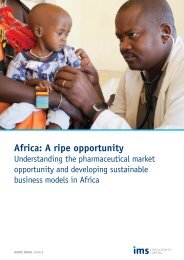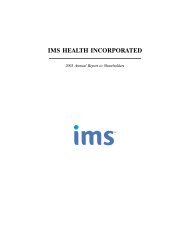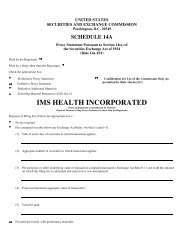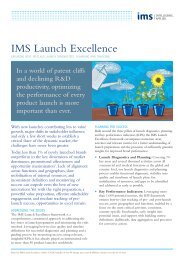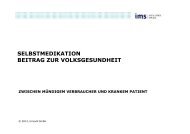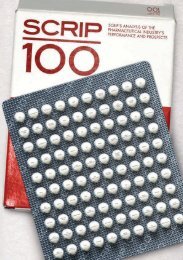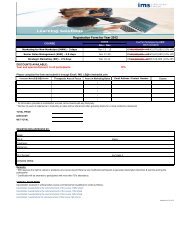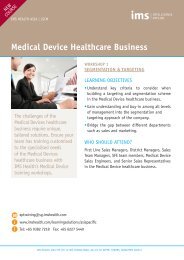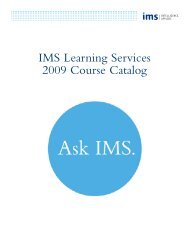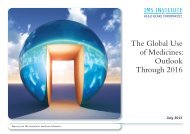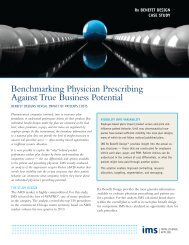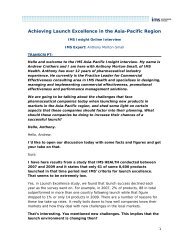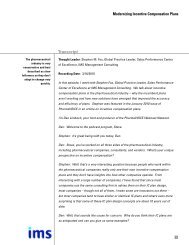The Evolution of Sales Models in the Indian Pharma ... - IMS Health
The Evolution of Sales Models in the Indian Pharma ... - IMS Health
The Evolution of Sales Models in the Indian Pharma ... - IMS Health
Create successful ePaper yourself
Turn your PDF publications into a flip-book with our unique Google optimized e-Paper software.
<strong>The</strong> <strong>Evolution</strong> <strong>of</strong> <strong>Sales</strong> <strong>Models</strong> <strong>in</strong> <strong>the</strong><br />
<strong>Indian</strong> <strong>Pharma</strong> Industry<br />
By AmArdeep Udeshi, engAgement mAnAger, ims ConsUlt<strong>in</strong>g groUp And mohit BAhri, ConsUltAnt, ims ConsUlt<strong>in</strong>g groUp
Dear colleagues,<br />
We are proud to present to you <strong>the</strong> outcome <strong>of</strong> a unique <strong>in</strong>itiative jo<strong>in</strong>tly undertaken by OPPI and <strong>IMS</strong><br />
Consult<strong>in</strong>g Group (<strong>IMS</strong>CG). As part <strong>of</strong> <strong>the</strong> OPPI Committee on <strong>Sales</strong> Force Excellence (SFE), a decision<br />
was taken last year to understand <strong>the</strong> prevail<strong>in</strong>g practices and emerg<strong>in</strong>g trends with respect to Sale<br />
Forces, aimed at driv<strong>in</strong>g SFE across <strong>the</strong> <strong>Indian</strong> <strong>Pharma</strong> <strong>in</strong>dustry. As part <strong>of</strong> this study, OPPI and <strong>IMS</strong><br />
<strong>Health</strong> undertook a survey amongst key senior management personnel, where<strong>in</strong> <strong>in</strong>formation was captured<br />
related to sales force structures, <strong>the</strong> pr<strong>in</strong>ciple beh<strong>in</strong>d <strong>the</strong>ir set ups and <strong>the</strong> challenges faced <strong>the</strong>re<strong>in</strong>.<br />
Fourteen companies responded to this survey. What is presented here is a brief glimpse <strong>of</strong> <strong>the</strong> f<strong>in</strong>d<strong>in</strong>gs <strong>of</strong><br />
this survey, with<strong>in</strong> <strong>the</strong> context <strong>of</strong> chang<strong>in</strong>g sales models <strong>in</strong> <strong>the</strong> <strong>Indian</strong> pharma <strong>in</strong>dustry. Support<strong>in</strong>g this<br />
data are <strong>in</strong>sights provided by <strong>IMS</strong> Consult<strong>in</strong>g Group based on <strong>the</strong>ir expertise and knowledge <strong>of</strong> <strong>the</strong> <strong>in</strong>dustry<br />
and its chang<strong>in</strong>g dynamics along with <strong>in</strong>puts from o<strong>the</strong>r <strong>in</strong>dustry experts associated with OPPI.<br />
What this paper attempts to do is to showcase how sales models are be<strong>in</strong>g, and will cont<strong>in</strong>ue to be, re<strong>in</strong>vented<br />
and redesigned across <strong>the</strong> <strong>Indian</strong> pharma market landscape <strong>in</strong> <strong>the</strong> years to come. We do hope<br />
you f<strong>in</strong>d this article and <strong>the</strong> subject as <strong>in</strong>terest<strong>in</strong>g as we found it to be while br<strong>in</strong>g<strong>in</strong>g this paper to you.<br />
Thank you,<br />
Tapan Ray Ram Kalyana<br />
Director General Country Pr<strong>in</strong>cipal, India<br />
OPPI <strong>IMS</strong> Consult<strong>in</strong>g Group<br />
2
<strong>the</strong> only ConstAnt is ChAnge itself<br />
<strong>The</strong> ever chang<strong>in</strong>g face <strong>of</strong> <strong>the</strong> <strong>Indian</strong> pharma <strong>in</strong>dustry<br />
and its ability to adapt <strong>in</strong>novatively has re<strong>in</strong>forced<br />
<strong>the</strong> fact that adaptation is <strong>the</strong> only way to survive. With<br />
every pass<strong>in</strong>g decade, a new commercial challenge has<br />
emerged; which <strong>in</strong>-turn has provided <strong>the</strong> <strong>in</strong>dustry with<br />
an opportunity to ride <strong>the</strong> waves to reach newer heights.<br />
An annual turnover <strong>of</strong> Rs 600 Bn with a CAGR <strong>in</strong> excess<br />
<strong>of</strong> 15% is a testimony to <strong>the</strong> fact that key players<br />
have emerged, w<strong>in</strong>n<strong>in</strong>g over time. With time, newer and<br />
<strong>in</strong>novative commercial approaches have been adopted<br />
and implemented, thus demonstrat<strong>in</strong>g that <strong>the</strong> companies<br />
have adapted <strong>the</strong>mselves to <strong>the</strong> fluidic nature <strong>of</strong> <strong>the</strong><br />
<strong>Indian</strong> pharma market.<br />
As Fig.1 below <strong>in</strong>dicates, follow<strong>in</strong>g <strong>the</strong> announcement <strong>of</strong><br />
a formal patent structure <strong>in</strong> 1995, <strong>Indian</strong> players started<br />
gear<strong>in</strong>g up for <strong>the</strong> product patent regime. Dur<strong>in</strong>g this<br />
time, a transition from conservative sales models to ag-<br />
Figure 1: Chang<strong>in</strong>g <strong>Sales</strong> Dynamics <strong>in</strong> <strong>the</strong> <strong>Indian</strong> <strong>Pharma</strong> Industry<br />
Announcement<br />
<strong>of</strong> patent regime<br />
• Companies start gear<strong>in</strong>g up<br />
for expansion<br />
• sf and portfolio ramp up<br />
• Avg new products launched/yr<br />
650-700<br />
• started <strong>in</strong>vestments <strong>in</strong> r&d<br />
massive restructur<strong>in</strong>g<br />
and scale up<br />
product patent<br />
implemented<br />
• rapid adoption <strong>of</strong> bus<strong>in</strong>ess unit structure<br />
• expansion to extra-urban geographies<br />
• emergence <strong>of</strong> newer sales model like<br />
taskforce, <strong>the</strong>rapy experts<br />
• Co-promotion/licens<strong>in</strong>g agreements kicked <strong>in</strong><br />
• rise <strong>of</strong> organized retail<br />
gressive and <strong>in</strong>novative sales models was observed. Companies<br />
geared up <strong>the</strong>ir R&D efforts to meet <strong>the</strong> product<br />
patent criteria, and undertook an aggressive expansion <strong>in</strong><br />
early 2000s from a gradual ramp up <strong>of</strong> portfolio and sales<br />
force <strong>in</strong> late 90s. So aggressive was <strong>the</strong> portfolio expansion,<br />
that <strong>the</strong> average number <strong>of</strong> new brands launch <strong>in</strong>creased<br />
from nearly 700/year <strong>in</strong> <strong>the</strong> late 1990s to >2,500/year<br />
between 2000 and 2005. At <strong>the</strong> same time, companies expanded<br />
<strong>the</strong>ir sales forces aggressively <strong>in</strong> attempts to reach<br />
out to <strong>the</strong> geographical corners <strong>of</strong> <strong>the</strong> country, <strong>in</strong>clud<strong>in</strong>g<br />
rural markets <strong>in</strong> <strong>the</strong> late 2000s. In a bid to <strong>in</strong>crease revenue<br />
fur<strong>the</strong>r, <strong>in</strong>novators engaged <strong>in</strong> co-promotion <strong>of</strong> <strong>the</strong>ir<br />
patented products and out-licens<strong>in</strong>g. At <strong>the</strong> same time,<br />
with limited options to expand portfolio and near saturation<br />
<strong>in</strong> <strong>the</strong> top cities <strong>in</strong> India, companies started adopt<strong>in</strong>g<br />
newer commercial models and sales force structures<br />
(like task forces, <strong>the</strong>rapy experts, Key Account Manager<br />
structure, Contracted <strong>Sales</strong> Operations, etc.) to more efficiently<br />
target <strong>the</strong> market.<br />
shr<strong>in</strong>k<strong>in</strong>g pipel<strong>in</strong>e and<br />
rise <strong>of</strong> pharmerg<strong>in</strong>g markets<br />
events likely to impact<br />
future sales models<br />
• health <strong>in</strong>surance<br />
• govt. adopt<strong>in</strong>g health security<br />
measures for certa<strong>in</strong> sections<br />
<strong>of</strong> society<br />
• gst regime<br />
• emergence <strong>of</strong> new stakeholders,<br />
sales channels<br />
• likely adoption <strong>of</strong> newer sales<br />
model like channel management,<br />
KAm, Cso, etc<br />
1995-2000 2000-2005 2005-2010 2010<br />
and beyond<br />
Future<br />
Source: <strong>IMS</strong> <strong>in</strong>telligence<br />
• Aggresive portfolio & sales force<br />
expansion, >2,500 new products launched/yr<br />
• gradual adoption <strong>of</strong> bus<strong>in</strong>ess unit structure<br />
• mnCs enter<strong>in</strong>g <strong>in</strong>dia and also launch<strong>in</strong>g<br />
global portfolio<br />
3
Companies who aggressively ramped-up were able to<br />
ma<strong>in</strong>ta<strong>in</strong> <strong>the</strong>ir bottom l<strong>in</strong>e, thus <strong>in</strong>dicat<strong>in</strong>g that <strong>the</strong>se<br />
strategies paid <strong>of</strong>f. A Top-level f<strong>in</strong>ancial assessment<br />
Figure 2: Pr<strong>of</strong>itability trends - Key companies<br />
40%<br />
35%<br />
30%<br />
25%<br />
20%<br />
15%<br />
10%<br />
5%<br />
0%<br />
MNCs<br />
However, <strong>in</strong> an ever chang<strong>in</strong>g market environment, <strong>the</strong><br />
susta<strong>in</strong>ability <strong>of</strong> <strong>the</strong>se models <strong>in</strong> terms <strong>of</strong> pr<strong>of</strong>itability<br />
needs to be carefully considered. Hence, it’s imperative<br />
for <strong>the</strong> <strong>in</strong>dustry to look with<strong>in</strong> for <strong>the</strong> opportunities to<br />
CUrrent sAles models<br />
<strong>The</strong> sales force cont<strong>in</strong>ues to be <strong>the</strong> biggest promotional<br />
<strong>in</strong>vestment for pharma players. Industry has<br />
evolved around mak<strong>in</strong>g most use <strong>of</strong> this resource and<br />
has adopted <strong>in</strong>novative commercial models, from sales<br />
and market<strong>in</strong>g structure to bus<strong>in</strong>ess unit structure to<br />
specialized task forces, as per <strong>the</strong>ir needs – <strong>of</strong>ten proactively<br />
adapt<strong>in</strong>g exist<strong>in</strong>g sales models to market realities<br />
In a survey jo<strong>in</strong>tly undertaken by <strong>IMS</strong>CG and OPPI<br />
amongst lead<strong>in</strong>g companies related to sales practices<br />
and models, it was observed that nearly 80% responded<br />
to hav<strong>in</strong>g changed <strong>the</strong>ir sales model at least once <strong>in</strong> <strong>the</strong><br />
last 5 years. Nearly 80% <strong>of</strong> <strong>the</strong> companies contacted<br />
by <strong>IMS</strong> have already adopted multiple bus<strong>in</strong>ess unit<br />
models, with or without additional specific task forces;<br />
with <strong>the</strong> number <strong>of</strong> bus<strong>in</strong>ess units rang<strong>in</strong>g from 2 to<br />
10, depend<strong>in</strong>g on portfolio width.<br />
(See Fig.2 below) shows that <strong>the</strong>se <strong>in</strong>itiatives have<br />
proved to be fruitful and provided healthy bottom<br />
l<strong>in</strong>es.<br />
2006 2007 2008 2009 2010<br />
-5%<br />
-10%<br />
2006 2007 2008 2009 2010<br />
novartis merck pfizer ranbaxy drl<br />
CiplA<br />
Astra<br />
% operat<strong>in</strong>g pr<strong>of</strong>it = operat<strong>in</strong>g pr<strong>of</strong>it/ operat<strong>in</strong>g <strong>in</strong>come<br />
source: www.money.rediff.com<br />
operat<strong>in</strong>g pr<strong>of</strong>it %<br />
<strong>Indian</strong> Companies<br />
Abbott Aventis glenmark sun pharma<br />
40%<br />
35%<br />
30%<br />
25%<br />
20%<br />
15%<br />
10%<br />
5%<br />
0%<br />
drive up efficiencies, be it through streaml<strong>in</strong><strong>in</strong>g operations,<br />
adapt<strong>in</strong>g <strong>the</strong>ir sales model to market realties, or<br />
enhanc<strong>in</strong>g efficacy <strong>of</strong> <strong>in</strong>itiatives.<br />
As an <strong>in</strong>dustry executive says, “We moved from a <strong>Sales</strong><br />
and Market<strong>in</strong>g structure to a Bus<strong>in</strong>ess Unit structure<br />
to br<strong>in</strong>g more accountability, manage evolv<strong>in</strong>g bus<strong>in</strong>ess<br />
needs and use equity <strong>of</strong> organization for reach<strong>in</strong>g<br />
to <strong>the</strong> middle <strong>of</strong> <strong>the</strong> accessible pyramid. We have<br />
also created a horizontal strategic excellence team across<br />
<strong>the</strong>se BUs for process evaluation.” Ano<strong>the</strong>r <strong>in</strong>dustry executive<br />
mentioned that adopt<strong>in</strong>g specialized field forces to<br />
promote super-specialty products, us<strong>in</strong>g a traditional field<br />
force to promote o<strong>the</strong>r less specialized products, and a CSO<br />
(Contracted <strong>Sales</strong> Operations) model for rural geographies<br />
has worked well for <strong>the</strong>m. Thus, <strong>the</strong> <strong>in</strong>dustry has seen an<br />
adoption <strong>of</strong> multiple k<strong>in</strong>ds <strong>of</strong> sales forces – an improvement<br />
over hav<strong>in</strong>g a ‘traditional sales force only’ model.<br />
While most <strong>of</strong> <strong>the</strong> companies have adopted this Bus<strong>in</strong>ess<br />
Unit structure, a few pushed fur<strong>the</strong>r ahead by adopt<strong>in</strong>g<br />
newer <strong>in</strong>novative promotional models like patient activation<br />
teams, <strong>the</strong>rapy specialists, or creat<strong>in</strong>g patient awareness<br />
through mass media.<br />
4
As seen <strong>in</strong> Fig.3 below, while key determ<strong>in</strong>ants <strong>of</strong> <strong>the</strong><br />
sales force structure are <strong>the</strong>rapy focus, portfolio width,<br />
Figure 3:<br />
<strong>the</strong>rapy focus<br />
portfolio (number <strong>of</strong> brands)<br />
specialty focus<br />
nature <strong>of</strong> product<br />
(otC/hospital based)<br />
geography focus<br />
stage <strong>in</strong> lifecycle <strong>of</strong> <strong>the</strong> portfolio<br />
mix <strong>of</strong> different pr<strong>of</strong>ibility brands<br />
realignment <strong>of</strong> brands due to<br />
merger/acquisition<br />
5.5<br />
0 2 4 6<br />
A few <strong>of</strong> <strong>the</strong> models seen <strong>in</strong> <strong>the</strong> pharma <strong>in</strong>dustry (see Fig. 4 below) are:<br />
and target doctor specialty, a few companies have also<br />
aligned <strong>the</strong>ir models around geographies and pr<strong>of</strong>itability.<br />
• <strong>the</strong>rApy foCUs promotion: Generally seen where a portfolio is specialized, <strong>the</strong>rapy focused, and scripts are<br />
driven through chosen few doctors; generally <strong>in</strong> chronic segment.<br />
• ChAnnel mAnAgement: Mostly <strong>in</strong> OTC /OTX bus<strong>in</strong>ess; mature products with wider portfolio width.<br />
• hospitAl tAsKforCe: Exclusively to manage hospital bus<strong>in</strong>ess.<br />
• speCiAlty driven sAles model: Applicable <strong>in</strong> scenarios where portfolio is built around 2 or 3 specialties.<br />
• tAsK forCe: Generally adopted for niche products <strong>in</strong> urban areas, such as fertility cl<strong>in</strong>ics or for new launches<br />
where <strong>the</strong> focus is on select top rung physicians only.<br />
• oUt-soUrCed sAles forCe: Generally used for expansion <strong>in</strong> extra-urban geographies or with companies for<br />
whom medico-market<strong>in</strong>g is secondary (such as OTC or Consumer <strong>Health</strong>care companies).<br />
Geography<br />
Figure 4: Newer <strong>Sales</strong> Force <strong>Models</strong> adopted<br />
Urban<br />
Urban<br />
+<br />
lower<br />
town<br />
classes<br />
rural<br />
task-force<br />
<strong>the</strong>rapy<br />
experts<br />
<strong>in</strong>stitutional<br />
sales force<br />
Channel<br />
sales<br />
distributor<br />
sales force<br />
superspecialty<br />
focus/<br />
niche<br />
hospital<br />
focus<br />
otC<br />
Portfolio<br />
non-exhaustive <strong>in</strong>dicative overview <strong>of</strong> <strong>in</strong>dian pharma sales models<br />
multispecialty<br />
broad<br />
portfolio<br />
multiple BU<br />
sales force<br />
rural sales<br />
force<br />
(owned /<br />
outsourced)<br />
6.7<br />
6.9<br />
6.9<br />
7.2<br />
8.9<br />
8.7<br />
9.2<br />
8 10<br />
<strong>the</strong>rapy focus<br />
specialty focus<br />
Acute vs chronic focus<br />
geography focus<br />
o<strong>the</strong>rs<br />
5
Different companies have adopted different strategies, but<br />
<strong>the</strong> key reason cited for adapt<strong>in</strong>g <strong>the</strong>se changes rema<strong>in</strong>s<br />
<strong>the</strong> same: to provide better customer focus and target<strong>in</strong>g,<br />
enhance efficiencies, facilitate expansion to newer bus<strong>in</strong>ess<br />
areas (both <strong>the</strong>rapies and geographies), and <strong>in</strong>crease<br />
accountability <strong>of</strong> <strong>the</strong> resources. One <strong>of</strong> <strong>the</strong> executives<br />
surveyed said, “We created multiple structures to expand<br />
coverage to new markets and <strong>the</strong>rapy areas <strong>in</strong> l<strong>in</strong>e with<br />
growth expectation, support new launches, and streng<strong>the</strong>n<br />
key markets & <strong>in</strong>stitutional sales.”<br />
For specialty products driven companies, task forces account<br />
for nearly 15% <strong>of</strong> <strong>the</strong> total sales force. Key determ<strong>in</strong>ants<br />
<strong>of</strong> adapt<strong>in</strong>g <strong>the</strong>se models are <strong>the</strong>rapy focus,<br />
width <strong>of</strong> product portfolio and target doctor specialties.<br />
Interest<strong>in</strong>gly, responses <strong>of</strong> those companies hav<strong>in</strong>g mature<br />
products tend<strong>in</strong>g to an OTX pr<strong>of</strong>ile suggest that channel<br />
management has already made <strong>in</strong>roads <strong>in</strong>to pharma sales,<br />
account<strong>in</strong>g for nearly 20% <strong>of</strong> sales forces, second only to<br />
traditional sales force.<br />
Geography also emerges as one <strong>of</strong> <strong>the</strong> key determ<strong>in</strong>ants<br />
<strong>of</strong> sales model adoption, which shows that companies are<br />
also look<strong>in</strong>g at realign<strong>in</strong>g <strong>the</strong>ir sales model around <strong>the</strong><br />
varied need <strong>of</strong> various geographies. An <strong>in</strong>dustry executive<br />
contacted by OPPI-<strong>IMS</strong> said “A new BU was created<br />
<strong>in</strong> our company to tap <strong>the</strong> opportunity <strong>in</strong> <strong>the</strong> lower<br />
town classes. <strong>The</strong> BU contribution to <strong>the</strong> overall bus<strong>in</strong>ess<br />
is close to 20%.” Ano<strong>the</strong>r executive said, “Emerg<strong>in</strong>g<br />
and untapped bus<strong>in</strong>ess <strong>in</strong> <strong>the</strong> Class 3 or 4 towns and<br />
rural sector will impact <strong>the</strong> future sell<strong>in</strong>g model,” thus<br />
Figure 5: Key benefits and challenges with various sales structures<br />
Account<br />
management<br />
Channel<br />
management<br />
hospital<br />
management<br />
task force<br />
structure<br />
Cso<br />
Benefits<br />
• high Customer focus<br />
• Customer management<br />
• Wider reach and frecuency<br />
• helpful <strong>in</strong> manag<strong>in</strong>g large portfolio<br />
• high focus on potential hospitals<br />
• high productivity for speciality bus<strong>in</strong>ess<br />
• high impact and productivity<br />
• service to focus customers<br />
• geographically better reach<br />
• flexibility <strong>in</strong> operation & reduces<br />
managerial cost<br />
acknowledg<strong>in</strong>g <strong>the</strong> seriousness around rural consumers.<br />
MNCs like Novartis, San<strong>of</strong>i-Aventis, Pfizer are actively<br />
expand<strong>in</strong>g to Tier IV cities and below, creat<strong>in</strong>g pr<strong>of</strong>itable<br />
bus<strong>in</strong>ess models around rural geographies. Extra-urban<br />
geographies require different sales models <strong>in</strong> addition to a<br />
different strategy <strong>in</strong> terms <strong>of</strong> portfolio, distribution, pric<strong>in</strong>g<br />
and promotion.<br />
It has also been observed that many companies have<br />
adopted a multi-pronged commercial model to target<br />
specific needs <strong>of</strong> <strong>the</strong> various customer sets. One <strong>of</strong> <strong>the</strong><br />
<strong>in</strong>dustry executives said, “We adopted multiple strategies,<br />
like divisionalization <strong>in</strong> different <strong>the</strong>rapy segment<br />
to br<strong>in</strong>g better focus on field implementation, creation<br />
<strong>of</strong> channel management to manage late life cycle brands,<br />
launch <strong>of</strong> an extra urban division to <strong>in</strong>crease reach, and<br />
launch <strong>of</strong> super specialty division like Derma & Cardio.”<br />
Previous studies from <strong>IMS</strong>CG suggest that this is not an<br />
isolated case, but is now a common practice followed by<br />
both <strong>Indian</strong> and MNC players.<br />
No one model fits all. As seen <strong>in</strong> Fig.5 below, different<br />
models have <strong>the</strong>ir share <strong>of</strong> benefits and challenges; <strong>in</strong>novative<br />
sales structures <strong>in</strong>crease customer focus, but with<br />
additional <strong>in</strong>vestment. Hence, one needs to study f<strong>in</strong>ancial<br />
feasibility <strong>of</strong> a adopt<strong>in</strong>g a new commercial model.<br />
While a few companies have started to reassess <strong>the</strong>ir sell<strong>in</strong>g<br />
model, many players still rely on traditional promotional<br />
channels, where doctor coverage, call frequency,<br />
and work<strong>in</strong>g days still def<strong>in</strong>e <strong>the</strong> KPIs for <strong>the</strong> sales force.<br />
Challenges<br />
• high <strong>in</strong>vestment<br />
• delay <strong>in</strong> payments<br />
• lower marg<strong>in</strong>s<br />
• resource constra<strong>in</strong>t for <strong>the</strong> wider reach<br />
• price war<br />
• formulary list<strong>in</strong>g for new products<br />
• scattered geography<br />
• Cost <strong>of</strong> operation<br />
• Compliance and quality <strong>of</strong> operations<br />
• tough to coord<strong>in</strong>ate and align Cso to<br />
parent company<br />
6
A closer look at current models show that <strong>the</strong>se models,<br />
though <strong>the</strong>y would have provided an edge to <strong>the</strong><br />
players, have largely focused around s<strong>in</strong>gle stakeholder,<br />
primarily doctors. A study by <strong>IMS</strong>CG shows that decision<br />
mak<strong>in</strong>g power <strong>of</strong> o<strong>the</strong>r stakeholders, <strong>in</strong>clud<strong>in</strong>g<br />
patients, hospitals, payers, and <strong>in</strong>surance companies, has<br />
Figure 6:<br />
Influential<br />
Weak<br />
International Scenario<br />
Doctors<br />
Media Promotion<br />
Payors Consumers<br />
Patient Groups<br />
Distribution channels<br />
Exist<strong>in</strong>g New<br />
Moreover, <strong>the</strong>re are fundamental differences <strong>in</strong> stakeholder<br />
evolution between Western and <strong>Indian</strong> markets,<br />
which to an extent expla<strong>in</strong>s <strong>the</strong> difference between<br />
commercial models <strong>in</strong> <strong>the</strong> West and <strong>in</strong> India. While<br />
doctors are still <strong>the</strong> center <strong>of</strong> healthcare <strong>in</strong> India, <strong>the</strong><br />
West has seen an emergence <strong>of</strong> consumers, payers, private<br />
<strong>in</strong>surance and patient groups as strong stakeholders<br />
<strong>in</strong> healthcare management. With Westernization <strong>of</strong><br />
<strong>the</strong> <strong>Indian</strong> healthcare market, newer stakeholders are<br />
been on a steady rise <strong>in</strong> recent years. Ris<strong>in</strong>g <strong>in</strong>fluence<br />
<strong>of</strong> new stakeholders <strong>in</strong> decid<strong>in</strong>g treatment pathway<br />
will force <strong>the</strong> market players to look at newer touch<br />
po<strong>in</strong>ts with new stakeholders and hence <strong>the</strong> promotional<br />
channels. KPIs for <strong>the</strong> sales team need to evolve<br />
to <strong>in</strong>clude <strong>the</strong>se new key stakeholders.<br />
Influential<br />
Weak<br />
<strong>Indian</strong> Scenario<br />
Doctors<br />
Distribution<br />
channels<br />
Consumers<br />
Media<br />
Promotion<br />
Insurance<br />
Patient Groups<br />
Exist<strong>in</strong>g New<br />
likely to ga<strong>in</strong> more importance, and thus will be <strong>the</strong><br />
need for newer ways and means <strong>of</strong> target<strong>in</strong>g <strong>the</strong>m.<br />
Lead<strong>in</strong>g MNCs like San<strong>of</strong>i-Aventis, Roche, Lilly,<br />
MSD, and GSK have already started engag<strong>in</strong>g newer<br />
stakeholders (patients) to ma<strong>in</strong>ta<strong>in</strong> <strong>the</strong>ir leadership <strong>in</strong><br />
<strong>the</strong> market. Awareness campaigns, as adopted by MSD<br />
for Gardasil or by GSK for its vacc<strong>in</strong>e portfolio or by<br />
San<strong>of</strong>i-Aventis for its top end brands have helped route<br />
<strong>the</strong> patients to <strong>the</strong>ir products.<br />
7
emerg<strong>in</strong>g trends <strong>in</strong> <strong>the</strong> heAlthCAre system<br />
OPPI-<strong>IMS</strong>CG has identified six key trends <strong>in</strong> healthcare which are likely to <strong>in</strong>fluence <strong>the</strong> way pharma companies<br />
adopt <strong>the</strong>ir sales models <strong>in</strong> <strong>the</strong> next decade. <strong>The</strong>se trends will see emergence <strong>of</strong> new stakeholders and promotional<br />
channels, that no company may afford to ignore, impact<strong>in</strong>g future commercial models. <strong>The</strong>se key trends are:<br />
1. pAtients <strong>in</strong>CreAs<strong>in</strong>gly BeCom<strong>in</strong>g strong stAKeholders:<br />
Increas<strong>in</strong>g education, awareness, and <strong>in</strong>come have prompted patients to actively seek a healthy life-style. Patients<br />
have emerged as stronger stakeholders <strong>in</strong> <strong>the</strong> overall treatment cha<strong>in</strong>, command<strong>in</strong>g what <strong>the</strong>y want, at<br />
<strong>the</strong> price <strong>the</strong>y want, where <strong>the</strong>y want and by whom. Demand for preventive treatment, ra<strong>the</strong>r than curative,<br />
is <strong>in</strong>creas<strong>in</strong>gly becom<strong>in</strong>g prom<strong>in</strong>ent amongst patients. Vacc<strong>in</strong>ation is a case <strong>in</strong> study, where companies like<br />
GSK and MSD have targeted primarily <strong>the</strong> end-user to ramp up patient acquisition. Increas<strong>in</strong>g use <strong>of</strong> health<br />
check-up packages, awareness creation through media promotion, and government <strong>in</strong>itiatives <strong>in</strong> rural healthcare<br />
will only lead to fur<strong>the</strong>r streng<strong>the</strong>n<strong>in</strong>g <strong>of</strong> patients as key stakeholders <strong>in</strong> <strong>the</strong> healthcare system.<br />
• Engages patients by provid<strong>in</strong>g services at<br />
<strong>the</strong>ir home for products like Arava and<br />
Actonel • engages patients by provid<strong>in</strong>g services<br />
at <strong>the</strong>ir home for products like Arava<br />
• Typical services <strong>in</strong>clude<br />
and Actonel<br />
• Counsel<strong>in</strong>g<br />
• Delivery <strong>of</strong> starter kits<br />
• Medical typical services Insurance <strong>in</strong>clude<br />
• Exercis<strong>in</strong>g • Counsel<strong>in</strong>g equipments<br />
• Physio<strong>the</strong>rapy • delivery starter sessions kits<br />
• Diagnostic Tests<br />
• medical <strong>in</strong>surance<br />
• Personalized visit<br />
• Emergency • exercis<strong>in</strong>g help equipments<br />
• physio<strong>the</strong>rapy sessions<br />
• Doctors • diagnostic are reported tests about <strong>the</strong> status <strong>of</strong> <strong>the</strong><br />
patients • personalized visit<br />
• Patient • emergency doesn’t has help to pay anyth<strong>in</strong>g extra<br />
• doctors are reported about <strong>the</strong> status <strong>of</strong><br />
<strong>the</strong> patients<br />
• patient doesn't has to pay anyth<strong>in</strong>g extra<br />
MNCs have been actively engag<strong>in</strong>g customers by provid<strong>in</strong>g disease management services to retail patients<br />
tak<strong>in</strong>g <strong>the</strong>ir products. Counsel<strong>in</strong>g, physio<strong>the</strong>rapy sessions, and diagnostic tests are all services be<strong>in</strong>g provided<br />
to patients. Patient reach programs will require different set ups and servic<strong>in</strong>g teams with specific skill sets.<br />
A lead<strong>in</strong>g MNC vacc<strong>in</strong>e player reaches out to <strong>the</strong>ir patients through an SMS rem<strong>in</strong>der service. An <strong>in</strong>dustry<br />
executive mentioned use <strong>of</strong> call centers for chronic disease management as a possibility. Thus, implementation<br />
<strong>of</strong> patient engagement programs will require adoption <strong>of</strong> different sales and service models, and hence<br />
newer capabilities by market players<br />
2. emergenCe <strong>of</strong> neW heAlthCAre delivery ChAnnels<br />
• Program is called as SPARSH<br />
• • •program Typical services is called <strong>in</strong>clude as spArsh<br />
• Counsel<strong>in</strong>g<br />
• Diagnostic tests<br />
• typical • Query services handl<strong>in</strong>g <strong>in</strong>clude via call center<br />
• Counsel<strong>in</strong>g<br />
• diagnostic tests<br />
• Patient doesn’t has to pay anyth<strong>in</strong>g extra<br />
• Query handl<strong>in</strong>g via call center<br />
• patient doesn't has to pay anyth<strong>in</strong>g extra<br />
<strong>The</strong> hospital segment is strongly emerg<strong>in</strong>g <strong>in</strong> <strong>the</strong> <strong>Indian</strong> healthcare sector. Private and corporate hospitals<br />
have grown at a 15-20% on YOY basis, and <strong>the</strong> trend is expected to cont<strong>in</strong>ue for <strong>the</strong> next 5 years as well.<br />
Penetration <strong>in</strong> Tier II cities and medical tourism will fur<strong>the</strong>r boost growth <strong>of</strong> corporate hospitals. <strong>The</strong> upcom<strong>in</strong>g<br />
<strong>in</strong>crease <strong>in</strong> number <strong>of</strong> corporate hospitals will result <strong>in</strong> a structure where players will not only require<br />
a hospital sales force, but also <strong>the</strong> key account managers to handle relationships with wider set <strong>of</strong> stakeholders<br />
like purchase managers, adm<strong>in</strong>istrative staff, and nurs<strong>in</strong>g staff. Most <strong>of</strong> <strong>the</strong> companies surveyed by <strong>IMS</strong> ei<strong>the</strong>r<br />
already have a hospital division, or are plann<strong>in</strong>g to have one <strong>in</strong> next 2-3 years.<br />
8
3. UptAKe <strong>of</strong> generiCs By government hospitAl seCtor<br />
Mandated prescrib<strong>in</strong>g <strong>of</strong> generics by government hospitals is expected to strongly impact <strong>the</strong> sales <strong>of</strong> branded<br />
drugs <strong>in</strong> <strong>the</strong> long run. Mandated generics prescription <strong>in</strong> <strong>the</strong> West has already led to emergence <strong>of</strong> new sales<br />
model aimed at generics promotion. Though <strong>IMS</strong>CG does not see this trend impact<strong>in</strong>g India much <strong>in</strong> next 5<br />
years, over next decade or so it will be <strong>in</strong>terest<strong>in</strong>g to see what new commercial models pharma players adopt.<br />
<strong>Pharma</strong> companies may also need to engage aggressively with government bodies like pric<strong>in</strong>g authorities, or<br />
approval committees.<br />
4. groW<strong>in</strong>g otC seCtor<br />
Use <strong>of</strong> media <strong>in</strong> driv<strong>in</strong>g brand promotion and reach<strong>in</strong>g out to masses has opened up a new avenue for <strong>Pharma</strong><br />
players to grow beyond traditional channels. Revital, Gelusil, Liv 52, Vol<strong>in</strong>i, No Marks, Croc<strong>in</strong> are <strong>the</strong> classic<br />
case studies, where pharma players expanded <strong>the</strong>ir reach through newer promotional channels like media<br />
promotion or <strong>in</strong>-store brand<strong>in</strong>g. Because OTC implies reach<strong>in</strong>g out to patients and consumers without<br />
doctor <strong>in</strong>tervention, it necessitates focus<strong>in</strong>g attention on pharmacies directly, develop<strong>in</strong>g new distribution<br />
models, pric<strong>in</strong>g and consumer target<strong>in</strong>g. <strong>Health</strong>care FMCG companies like GSKCH, Nestle and Britannia<br />
have a dedicated medical detail<strong>in</strong>g field force meet<strong>in</strong>g doctors and nutritionists to promote <strong>the</strong>ir brand<br />
too. Emergence <strong>of</strong> OTC is fur<strong>the</strong>r expected to catch-up <strong>in</strong> next 5-10 years, with many more companies<br />
eye<strong>in</strong>g to acquire a broader patient base through multi-channel market<strong>in</strong>g. Hence, pharmacos need to adopt a<br />
different model for target<strong>in</strong>g customers<br />
5. orgAnized retAil phArmACy ChA<strong>in</strong>s<br />
Increas<strong>in</strong>g spread <strong>of</strong> organized pharmacy cha<strong>in</strong>s like Apollo, Guardian and 98.4, will make pharma players<br />
th<strong>in</strong>k about manag<strong>in</strong>g <strong>the</strong> grow<strong>in</strong>g power <strong>of</strong> newer distribution channels. Accord<strong>in</strong>g to <strong>in</strong>dustry estimates,<br />
organized retail pharmacy cha<strong>in</strong>s already account for nearly 5% <strong>of</strong> pharma sales <strong>in</strong> India, and <strong>the</strong>ir share is<br />
<strong>in</strong>creas<strong>in</strong>g year on year. <strong>The</strong>se cha<strong>in</strong>s cannot be ignored any longer. Over a period <strong>of</strong> time, <strong>the</strong> role <strong>of</strong> organized<br />
players may evolve from mere distribution <strong>of</strong> drugs to manag<strong>in</strong>g patients’ health. <strong>Pharma</strong> companies may<br />
need to th<strong>in</strong>k about how to engage with <strong>the</strong>se cha<strong>in</strong>s to deliver more and more services to <strong>the</strong>ir patients.<br />
With <strong>in</strong>creas<strong>in</strong>g share <strong>of</strong> sales, <strong>the</strong> demand for fur<strong>the</strong>r discount<strong>in</strong>g by <strong>the</strong>se cha<strong>in</strong>s is not far away. Not only<br />
will <strong>the</strong>se pharmacies demand price discount<strong>in</strong>g, <strong>the</strong>y will impact <strong>the</strong> way <strong>the</strong> supply cha<strong>in</strong> is currently structured.<br />
With media promotion driv<strong>in</strong>g <strong>the</strong> customer pull, merchandis<strong>in</strong>g will take a bigger role <strong>in</strong> overall sales<br />
promotion at <strong>the</strong>se pharmacies. Thus, <strong>the</strong> association between pharmacos and <strong>the</strong>se cha<strong>in</strong>s needs to grow <strong>in</strong><br />
a manner that both parties benefit from <strong>the</strong> <strong>in</strong>ter-play.<br />
6. rise <strong>of</strong> heAlth <strong>in</strong>sUrAnCe<br />
Increas<strong>in</strong>g penetration <strong>of</strong> health <strong>in</strong>surance will <strong>in</strong>crease power <strong>of</strong> <strong>in</strong>surance companies to decide <strong>in</strong>clusion or<br />
exclusion <strong>of</strong> drugs <strong>in</strong> re-imbursement list. It is expected that <strong>the</strong> total population covered under health <strong>in</strong>surance<br />
will <strong>in</strong>crease from 2.3% <strong>in</strong> 2007 to 20% by 2015. <strong>The</strong> possibile emergence <strong>of</strong> a drug re-imbursement<br />
list by <strong>Indian</strong> <strong>in</strong>surance companies cannot be ruled out, which may eventually lead to dictat<strong>in</strong>g <strong>the</strong> bus<strong>in</strong>ess<br />
terms by <strong>in</strong>surance companies to pharma players.<br />
• Companies like ICICI Lombard are now eye<strong>in</strong>g to launch disease specific <strong>in</strong>surance cover<strong>in</strong>g cost <strong>of</strong><br />
medications as well. One such policy, called Diabetes Care, is already <strong>in</strong> <strong>the</strong> market.<br />
9
Includ<strong>in</strong>g <strong>in</strong>surance companies as a key stakeholder <strong>in</strong><br />
<strong>Pharma</strong> commercial model products will <strong>in</strong>creas<strong>in</strong>gly<br />
become crucial.<br />
Each <strong>of</strong> <strong>the</strong> above trends will impact <strong>the</strong> pharma sales<br />
model <strong>in</strong> <strong>the</strong>ir own way, pav<strong>in</strong>g <strong>the</strong> way for new commercial<br />
models <strong>in</strong> <strong>the</strong> pharmaceutical <strong>in</strong>dustry. Industry<br />
also seems to acknowledge <strong>the</strong>se trends as one <strong>in</strong>dustry<br />
executive stated, “<strong>Sales</strong> structures will evolve to manage<br />
new channels like corporate hospitals or modern format<br />
retail. Government policies, payers and healthcare providers<br />
will <strong>in</strong>fluence <strong>the</strong> sales models <strong>of</strong> pharma play-<br />
AdApt<strong>in</strong>g neW CommerCiAl models<br />
Emerg<strong>in</strong>g trends <strong>in</strong> healthcare delivery will force <strong>the</strong><br />
pharma players to re-th<strong>in</strong>k about <strong>the</strong>ir go-to-market<br />
strategy. Some key questions to ask are:<br />
• Is my current sales model susta<strong>in</strong>able <strong>in</strong> <strong>the</strong> future?<br />
• Is my current sales model optimal for future market<br />
scenario?<br />
• How should I evolve and adapt to <strong>the</strong>se changes?<br />
Answers are not easy to come by, but a few companies<br />
will lead <strong>the</strong> way. Accord<strong>in</strong>g to <strong>the</strong> OPPI-<strong>IMS</strong>CG<br />
study, key players <strong>in</strong> <strong>the</strong> <strong>in</strong>dustry believe that adaptation<br />
<strong>of</strong> current sales model will be a must for survival.<br />
With <strong>the</strong> emergence <strong>of</strong> <strong>in</strong>novative sales models like<br />
key account management, hospital task force, channel<br />
management, <strong>the</strong>rapy specialist, and media promotion,<br />
it is clear where sales models are head<strong>in</strong>g. Companies<br />
Figure 7:<br />
sales representative roles fairly<br />
standardized<br />
reach and frequency paradigm<br />
share <strong>of</strong> voice<br />
sf ma<strong>in</strong> promotional channel<br />
molecular target<strong>in</strong>g<br />
<strong>in</strong>dividual <strong>in</strong>centives<br />
technology used by <strong>in</strong>novators<br />
sfe function <strong>in</strong>frequent<br />
empirical decision mak<strong>in</strong>g<br />
ers,” while ano<strong>the</strong>r mentioned “<strong>Sales</strong> force will have to<br />
manage end customer connect besides market<strong>in</strong>g brands<br />
to doctors”. Ano<strong>the</strong>r executive feels patients will ga<strong>in</strong><br />
more importance <strong>in</strong> future, say<strong>in</strong>g, “Most companies will<br />
have focused approach and work towards better customer<br />
service lead<strong>in</strong>g to patient benefit.” OPPI-<strong>IMS</strong>CG feels<br />
that as <strong>the</strong> momentum <strong>of</strong> evolution <strong>of</strong> <strong>the</strong>se trends ga<strong>the</strong>r<br />
pace, so will <strong>the</strong> evolution <strong>of</strong> pharma commercial models<br />
<strong>in</strong> <strong>the</strong> next decade. With <strong>the</strong>se changes, <strong>the</strong> <strong>in</strong>dustry has<br />
witnessed an emergence <strong>of</strong> <strong>the</strong> concept <strong>of</strong> SFE – <strong>Sales</strong><br />
Force Excellence.<br />
are seriously look<strong>in</strong>g to have a dedicated team for rural<br />
markets. Each <strong>of</strong> <strong>the</strong>se models clearly po<strong>in</strong>ts towards<br />
targeted approach to new stakeholders, though it’s too<br />
early to predict <strong>the</strong> nuances <strong>of</strong> each <strong>of</strong> <strong>the</strong> models.<br />
<strong>The</strong> role <strong>of</strong> exist<strong>in</strong>g resources will also evolve from<br />
mere touch po<strong>in</strong>ts with customers to engag<strong>in</strong>g f<strong>in</strong>al<br />
consumers and manag<strong>in</strong>g <strong>the</strong> health <strong>of</strong> <strong>the</strong> patients.<br />
One <strong>in</strong>dustry executive po<strong>in</strong>ts out, “<strong>Pharma</strong> sales<br />
structure will slowly move towards a more scientific<br />
dialogue between <strong>the</strong> sales force and <strong>the</strong> doctor. This<br />
would require highly tra<strong>in</strong>ed MRs with good ability<br />
to engage doctors more effectively.”<br />
This question will be even more pert<strong>in</strong>ent go<strong>in</strong>g forward;<br />
especially keep<strong>in</strong>g <strong>in</strong> m<strong>in</strong>d how difficult it is gett<strong>in</strong>g<br />
to f<strong>in</strong>d good talent <strong>in</strong> <strong>the</strong> market and how to make<br />
exist<strong>in</strong>g talent more effective and productive through<br />
skill-set enhancement.<br />
yesterday today/tomorrow<br />
different roles: (KAm, relationships<br />
rep, sample dropper and power rep)<br />
relationship paradigm<br />
share <strong>of</strong> relationship<br />
mC2 = multi-client/multi-channel<br />
Atomistic target<strong>in</strong>g<br />
team <strong>in</strong>centives<br />
effective use <strong>of</strong> technology<br />
sfe function contribut<strong>in</strong>g to roi<br />
evidence-based decision mak<strong>in</strong>g<br />
10
<strong>The</strong> OPPI-<strong>IMS</strong>CG study predicts <strong>the</strong> gradual shift <strong>of</strong><br />
<strong>the</strong> traditional approach <strong>of</strong> meet<strong>in</strong>g <strong>the</strong> customer, to future<br />
approach <strong>of</strong> relationship build<strong>in</strong>g and engag<strong>in</strong>g with<br />
customers. Much will change. “Manag<strong>in</strong>g <strong>the</strong> patients toge<strong>the</strong>r”<br />
is perceived to be <strong>the</strong> key to success. Del<strong>in</strong>k<strong>in</strong>g<br />
<strong>the</strong> role <strong>of</strong> sales force from stockist management will help<br />
sales teams to focus exclusively on customers. Engag<strong>in</strong>g<br />
multiple stakeholders through multi-channel promotion<br />
and touch-po<strong>in</strong>ts will be <strong>the</strong> crucial. Segment<strong>in</strong>g <strong>the</strong> customers,<br />
from current Potential-Support Model to more<br />
evolved models like Behavioral Segmentation will provide<br />
<strong>the</strong> cutt<strong>in</strong>g edge to <strong>the</strong> players. e-detail<strong>in</strong>g, e-sem<strong>in</strong>ars,<br />
e-doctor meet<strong>in</strong>gs, and onl<strong>in</strong>e awareness campaigns<br />
will drive <strong>the</strong> patient flow to <strong>the</strong> healthcare system. Thus,<br />
KPIs for <strong>the</strong> sales forces may evolve as well.<br />
Industry experts also predict that evolv<strong>in</strong>g and harvest<strong>in</strong>g<br />
newer touch po<strong>in</strong>ts with patients will be a key to success.<br />
Study <strong>of</strong> patient flows <strong>in</strong> healthcare is likely to ga<strong>in</strong><br />
importance. Not only will patient flow study impact <strong>the</strong><br />
sales model, it will also impact <strong>the</strong> portfolio choice for <strong>the</strong><br />
players. An <strong>in</strong>dustry executive po<strong>in</strong>ted out, “Key Account<br />
Management will have <strong>in</strong>creas<strong>in</strong>g importance for MNCs<br />
with pipel<strong>in</strong>e <strong>of</strong> patented products and strategic partner<strong>in</strong>g<br />
<strong>in</strong>itiative will also impact sales models.”<br />
With<strong>in</strong> <strong>the</strong> last 5 to 6 years, companies have also created<br />
a dedicated SFE function, with <strong>the</strong> purpose <strong>of</strong> improv<strong>in</strong>g<br />
<strong>the</strong> productivity <strong>of</strong> <strong>the</strong> sales forces. <strong>The</strong> role <strong>of</strong> SFE is<br />
expected to evolve strongly over <strong>the</strong> next 5 years, <strong>in</strong>volv-<br />
Figure 8:<br />
Smaller field<br />
forces:<br />
removal <strong>of</strong><br />
mirrored field forces<br />
Right siz<strong>in</strong>g:<br />
each rep see<strong>in</strong>g<br />
30-40 doctors<br />
more <strong>of</strong>ten<br />
Account based<br />
sell<strong>in</strong>g: manag<strong>in</strong>g<br />
groups <strong>of</strong> prescribers<br />
based on % effort and<br />
not reach & frequency<br />
Key Account Mgt:<br />
relationship rep can<br />
call <strong>in</strong> specialized<br />
personnel as needed<br />
<strong>the</strong> sales<br />
model <strong>of</strong><br />
Today<br />
MNCs are expected to lead <strong>the</strong> change and that trend <strong>of</strong><br />
micro-target<strong>in</strong>g has already begun. Companies like MSD,<br />
San<strong>of</strong>i-Aventis, and Roche have shown that value, and not<br />
cost, drives <strong>the</strong> healthcare choice. Januvia, (though much<br />
lesser than <strong>in</strong>ternational price) is priced much higher and<br />
<strong>in</strong>g <strong>in</strong>-depth analytics so as to lead to scientific decision<br />
mak<strong>in</strong>g; from coord<strong>in</strong>at<strong>in</strong>g sales force activities to manag<strong>in</strong>g<br />
ROI through <strong>in</strong>formed decision mak<strong>in</strong>g with an end<br />
objective <strong>of</strong> improv<strong>in</strong>g efficiencies <strong>of</strong> exist<strong>in</strong>g systems.<br />
As one executive said, “<strong>The</strong>re will be a concerted focus<br />
on SFE. Analytics will take over an important role <strong>in</strong> decid<strong>in</strong>g<br />
sales force size and predict<strong>in</strong>g sales forecast.” Measures<br />
<strong>of</strong> success will shift from PRPM model to carry-over<br />
models, thus, each <strong>in</strong>cremental sales rep be<strong>in</strong>g added to<br />
sales force will have its own justification. With erod<strong>in</strong>g<br />
product differentiation <strong>the</strong> sales and market<strong>in</strong>g capabilities<br />
will be <strong>the</strong> key differentiator. <strong>The</strong> <strong>Indian</strong> pharma <strong>in</strong>dustry<br />
will need to develop sales force competency and<br />
elements <strong>of</strong> SFE will take <strong>the</strong> driv<strong>in</strong>g seat. <strong>The</strong> reward<br />
systems will <strong>in</strong>corporate balance <strong>of</strong> sales achievement<br />
with equal emphasis <strong>in</strong> effort parameters.<br />
Consider<strong>in</strong>g that <strong>the</strong> largest resource allocation <strong>in</strong> companies<br />
takes place on sales teams, it becomes important<br />
that SFE as a function be evaluated more seriously. In<br />
order to <strong>in</strong>stitutionalize <strong>the</strong> discipl<strong>in</strong>e <strong>of</strong> SFE, companies<br />
will need to build capabilities for an enterprise-wide SFE<br />
setup which will be actively engaged <strong>in</strong> enabl<strong>in</strong>g <strong>in</strong>vestments<br />
<strong>in</strong>to <strong>in</strong>novative and hybrid sales models or demand<br />
generation models. To do this successfully and build a<br />
better bus<strong>in</strong>ess case for <strong>the</strong> same, companies will need<br />
to closely exam<strong>in</strong>e how <strong>in</strong>vestments are channelized <strong>in</strong>to<br />
each <strong>of</strong> <strong>the</strong> various <strong>in</strong>itiatives – balanc<strong>in</strong>g f<strong>in</strong>ancial rigour<br />
with overall implementability.<br />
Prescriber Knowledge<br />
opportunity - Accessibility - responsiveness<br />
Organizational <strong>Models</strong><br />
<strong>the</strong>rapy focused - team based - outsourc<strong>in</strong>g<br />
specialist - Key Account mgt.<br />
new bonus and compensation models<br />
patient flow - local guidel<strong>in</strong>es/Bodies<br />
<strong>in</strong>fluence to diagnose & prescribe<br />
Portfolio Treatment Pathways & Influence<br />
<strong>the</strong> sales<br />
model <strong>of</strong><br />
<strong>The</strong> Future<br />
entered recently <strong>in</strong> <strong>the</strong> market, has already clocked sales<br />
<strong>of</strong> >Rs 100 crs. Thus, its well said by a pharma executive:<br />
“<strong>The</strong> way <strong>of</strong> market<strong>in</strong>g differentiated products, depend<strong>in</strong>g<br />
on <strong>the</strong>ir life cycle stage, will be <strong>of</strong> utmost importance.<br />
Newer ways <strong>of</strong> promotion too will have to be considered.”<br />
11
Conclusion<br />
Decl<strong>in</strong><strong>in</strong>g effectiveness <strong>of</strong> current sales models will only<br />
lead to emergence <strong>of</strong> newer approaches <strong>in</strong> pharma sell<strong>in</strong>g.<br />
Though <strong>the</strong> approaches will vary vastly from company<br />
to company, <strong>the</strong> trend has already started. <strong>Pharma</strong>ceutical<br />
players should seriously start evaluat<strong>in</strong>g <strong>the</strong>ir options<br />
and envisage how <strong>the</strong>ir sales models should evolve <strong>in</strong> <strong>the</strong><br />
next 10 years to ma<strong>in</strong>ta<strong>in</strong> <strong>the</strong>ir competitive edge. Where<br />
does <strong>the</strong> future lie? Is KAM <strong>the</strong> solution,or is it <strong>the</strong> CSO<br />
that will emerge? Will channel management ga<strong>in</strong> most<br />
importance? To what extent should market coverage be<br />
<strong>in</strong>creased? How would one need to balance this with<br />
cost effectiveness?<strong>The</strong> answers will emerge only with <strong>the</strong><br />
time, but with market matur<strong>in</strong>g, patients actively seek<strong>in</strong>g<br />
healthcare, and newer stakeholders emerg<strong>in</strong>g, ano<strong>the</strong>r<br />
round <strong>of</strong> adaptation <strong>in</strong> pharma sales model is <strong>in</strong>evitable.<br />
No s<strong>in</strong>gle bus<strong>in</strong>ess model may suffice <strong>in</strong> future. <strong>The</strong> future<br />
will belong to hybrid bus<strong>in</strong>ess models, with different<br />
structures co-exist<strong>in</strong>g toge<strong>the</strong>r.<br />
We would like to acknowledge <strong>the</strong> contributions <strong>of</strong> <strong>the</strong> follow<strong>in</strong>g OPPI – SFE Committee Members :<br />
Mr. Rajan Tejuja, Chairman, OPPI SFE Committee and President & Executive Director, Johnson & Johnson Ltd.<br />
Mr. V<strong>in</strong>ay Gokhale, Vice Chairman, OPPI SFE Committee and <strong>Sales</strong> Tra<strong>in</strong><strong>in</strong>g & Development Manager, Abbott India Ltd.<br />
Mr. Sekar Sabapathy, Member, OPPI SFE Committee and Senior Director – Cardiology & Hospital BU, Aventis <strong>Pharma</strong> Ltd. (Group San<strong>of</strong>i Aventis).<br />
Mr. Biplab Chatterjee, Member, OPPI SFE Committee and Vice President – <strong>Sales</strong>, Solvay <strong>Pharma</strong> India Ltd.<br />
Mr. Partha Ghosh, Member, OPPI SFE Committee and Director, Commercial, Pfizer Ltd.<br />
Mr. Vivek Padgaonkar, Director, OPPI.<br />
ABoUt ims ConsUlt<strong>in</strong>g groUp:<br />
<strong>in</strong>flUenC<strong>in</strong>g <strong>the</strong> fUtUre <strong>of</strong> gloBAl heAlth<br />
<strong>IMS</strong> Consult<strong>in</strong>g Group (<strong>IMS</strong>CG) is <strong>the</strong> pre-em<strong>in</strong>ent global life sciences<br />
consultancy. Dist<strong>in</strong>guished by our sector and client focus, <strong>in</strong>ternational<br />
reach, world-class methodologies and unrivaled talent, we provide<br />
clients with Powerful Insights that <strong>in</strong>form Smarter Decisions.<br />
With<strong>in</strong> <strong>IMS</strong>CG, we have a bold vision<br />
- To Influence <strong>the</strong> Future <strong>of</strong> Global <strong>Health</strong>!<br />
Who We Are:<br />
• 500+ specialist best-<strong>in</strong>-class consultants<br />
•Advis<strong>in</strong>g Life Science leaders on critical bus<strong>in</strong>ess issues with s<strong>in</strong>gular focus<br />
• Cadre <strong>of</strong> health/pharma-related backgrounds and advanced degrees<br />
Where We Are:<br />
• Comb<strong>in</strong><strong>in</strong>g global reach with local market strength<br />
• Key hubs <strong>in</strong> London, NewYork, Shanghai and Tokyo<br />
• Local experts on <strong>the</strong> ground <strong>in</strong> pharmerg<strong>in</strong>g markets -Ch<strong>in</strong>a, Brazil,<br />
India, Russia, Turkey, and more<br />
hoW We mAKe <strong>the</strong> differenCe:<br />
• Maximiz<strong>in</strong>g product & portfolio value <strong>in</strong> every phase <strong>of</strong> <strong>the</strong><br />
pharma lifecycle<br />
• Deep <strong>the</strong>rapy-area and <strong>in</strong>dustry expertise<br />
• Passion for life sciences and commitment to clients<br />
ims ConsUlt<strong>in</strong>g groUp<br />
<strong>IMS</strong> HEALTH INFORMATION<br />
& CONSULTING SERVICES<br />
INDIA PVT. LTD.<br />
ICC Chambers, 4th Floor,<br />
Saki-Vihar Road,<br />
Powai, Mumbai – 400 072<br />
India<br />
www.imsconsult<strong>in</strong>ggroup.com<br />
12


